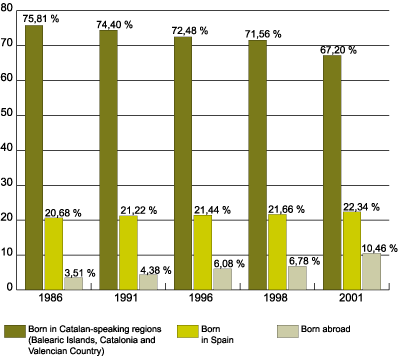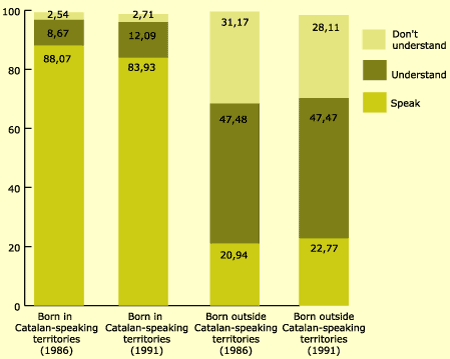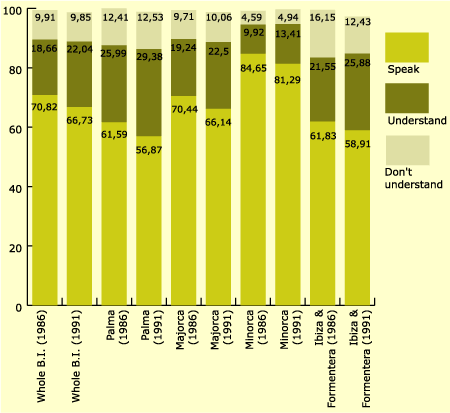
| Sociolingüística catalana |
| Winter 2002 |
Linguistic skills and language use in the Balearic Islands. A review of the studies carried out by institutions and other organisations, by Joan-Albert Villaverde i Vidal |
||||
|
Summary 2. Demographic trends in the Balearic Islands 3. Population censuses and data from municipal records 4.
Surveys made throughout the Balearic Islands 5.
Surveys with a smaller scope Most of the studies reviewed are quantitative studies based on closed question questionnaires through which the interviewees provide information about their linguistic skills and their use of languages in different domains. This type of study presents several problems that cannot be ignored. It should be stressed that thanks to these techniques we obtain more information on users’ perception of their own linguistic skills and habits of use than reliable data about actual linguistic knowledge and use. Furthermore, although these works share a common methodology and set of objectives, they only very occasionally manage to fully coincide in the criteria employed (for example, the items of the questionnaires or the treatment of variables such as the first language of those interviewed, etc.). This is why the results of the different studies are not fully comparable. On the other hand, the authors often have to face problems when establishing truly representative samples of the whole of the populations in question given the legal impossibility of obtaining access to population censuses, they have to rely on electoral censuses that do not include people under the age of eighteen -or immigrants who do not have the vote- that is, two highly relevant groups in the demolinguistic environment. Nevertheless, these studies are interesting, insofar as they give a description of the sociolinguistic situation. If the data provided are not mutually contradictory and the researcher takes into account the above-mentioned methodological problems, such studies are a useful source of information that allows us to observe general trends. 2. Demographic evolution of the Balearic Islands In order to set in context the information given in the following pages we must take into account the demographic trends of the Balearic Islands over the past 15 years, which is characterized by a strong and still ongoing increase in the presence of people born outside Catalan-speaking regions. Table 0 and graph 1 show this trend. We have moreover to bear in mind that a part of the locally born population are children of first generation immigrants and in many cases reproduce the linguistic behaviour of their parents.Table
0. Evolution of the population of the Balearic Islands 1986-2001
Graph
1. Evolution of the proportion of autochtonous
Source: IBAE/INE 3. Population censuses and the data of municipal registers The inclusion of questions related to linguistic knowledge in population censuses and municipal registers would have provided highly relevant information updated every 5 years about the linguistic skills of the residents of the Balearic Islands. Unfortunately, up to now the only reliable data available are those of the 1986 update of the municipal register. The data gathered by the 1991 census show considerable skewing (mainly those refering to speaking ability) due to the use of the term Catalan in the question (this caused that many people replied negatively as they did not identify their language with that name) (1). There was no question about languages in the 1996 update of the municipal register. Finally, this question was introduced once again in the 2001 census but framed in a different way compared to 1986 and 1991 (see further details below). Both the municipal register and the census provide information about the four linguistic abilities: understanding, speaking, reading and writing. Graphs 2 and 3 show the data from the 1986 municipal register and the 1991 census (2). The first states distribution according to geographical origin of the interviewees; the second states distribution in the different islands. (Discrepancies in adding up to 100% are due to people for whom there is no available answer).
Graph
2. Linguistic competence according to the place
Graph
3. Linguistic competence according to the place
4. Surveys made throughout the Balearic Islands We have at our disposal three surveys of the Centro de Investigaciones Sociológicas (CIS) providing information about linguistic skills and language use in the Balearic Islands, i.e. surveys #2052, 2228 and 2300. The first and the last survey used the same questionnaire so that the data are comparable. In the case of the second, both the questionnaire and the sample were reduced. Let us look first at study 2228, carried out in 1996. It gives information about linguistic skills, the mother tongue of the interviewees and language use in several domains, as well as gathering the opinion of the informants towards the language and its social extension. According to the survey, Catalan is the mother tongue of 58.2% of the interviewees; 37% have Spanish as mother tongue; 3% claim to be bilingual (Catalan and Spanish as mother tongues), while 1.4% have another mother tongue. As for knowledge of Catalan, 91% understand it and 62,3% speak it fluently. |


